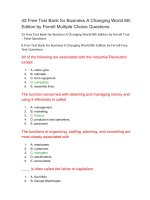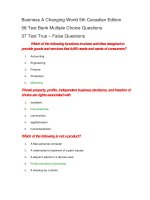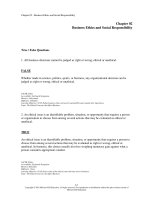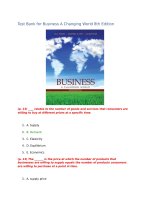Business a changing world 7e by ferrell chap012
Bạn đang xem bản rút gọn của tài liệu. Xem và tải ngay bản đầy đủ của tài liệu tại đây (2.26 MB, 41 trang )
12-1
Business in a
Changing World
Chapter 12
Customer-Driven Marketing
McGraw-Hill/Irwin
Copyright © 2009 by the McGraw-Hill Companies, Inc. All rights
12-3
David’s Bridal: Captured 30%
of the wedding dress market.
In the past 60 years, the bridal industry has
reinvented itself numerous times. David’s Bridal
enters the market in the 1990’s and has never
looked back.
12-4
The Importance of Marketing
Planning & execution to satisfy customer
goals –
•Product development
•Product pricing
•Product promotion
•Distribution of goods, ideas, services
12-5
The Nature of Marketing
MARKETING
The group of activities that add value and
designed to expedite transactions by creating,
distributing, pricing, and promoting goods,
services and ideas.
12-6
The Nature of Marketing
•Marketing is NOT –
•Manipulating consumers
•Selling & advertising
•Marketing IS –
•Satisfying consumers
12-7
Marketing
The Exchange Relationship – act of giving up one thing
(money, credit, labor, goods) in return (exchange) for
something else (goods, services, or ideas)
12-8
Marketing – The Exchange Relationship
The Exchange Process: Giving Up One Thing in Return for Another
12-9
Functions of Marketing
Industry groups use
marketing to increase
demand for the industry’s
product.
America’s Beef Producers
12-10
Functions of Marketing
•Buying
•Selling
•Transporting
•Storing
•Grading
•Financing
•Marketing research
•Risk taking
12-11
The Marketing Concept
The idea that an organization should try to satisfy customers’
needs through coordinated activities that also allow it to
achieve its own goals.
12-12
The Marketing Concept
•Marketing Goal –
•Customer satisfaction
•Achieve business objectives
•Boost productivity
•Reduce costs
•Capture market share
12-13
Implementing the Marketing Concept
•Good information re: customer wants
•Consumer orientation
•Coordinate organizational efforts
Customer’s perception of value = measure of success
12-14
The Marketing Concept
•46% executives believe firm is customer focused
•67% executives frequently meet with customers
Marketing is more important as markets are more competitive
12-15
The Marketing Concept
Production Orientation – 19th century
•manufacturing efficiency
Sales Orientation – early 20th century
•Supply exceeds demand – need to “sell” products
Marketing Orientation – 1950’s
•First determine what customers want
12-16
The Marketing Concept
Marketing Orientation – approach requiring
organizations to gather information about
customer needs, share information across firm,
use information to build long-term relationships
with customers.
12-17
Marketing Orientation
Wrigley’s sells products in 180 countries.
Continues to reinvent itself; in 2008, merger
with candy maker Mars.
12-18
Developing a Marketing Strategy
Marketing strategy – plan of action for
developing, pricing, distributing, and promoting
products meeting the needs of specific customers.
12-19
Developing a Marketing Strategy
Target Market – very specific group of consumers
that a company focuses its marketing efforts to
(e.g. Nike – golf clubs for recreational golfers).
12-20
Developing a Marketing Strategy
Total-market approach – firm tries to appeal to
everyone and assumes that all buyers have similar
needs.
(e.g. Salt, sugar, agricultural products).
12-21
Developing a Marketing Strategy
Market segmentation – strategy to divide the total
market into groups of people with relatively similar
product needs.
Market segment – collection of individuals, groups or
organizations sharing one or more characteristics
thus having relatively similar needs and desires for
products.
12-22
Market Segmentation
Minority Buying Power by Race, 1990 versus
2003 & 2005
12-23
Total-Market
Approach
12-24
Market Segmentation Approaches
Concentration – company develops one
marketing strategy for a single market segment.
Specialization (e.g. Porsche’s focus on highincome individuals)
Multi-segment – aims at two or more segments
with strategy for each. (e.g. Raleigh bicycles for
racers, commuters, and children)
12-25









